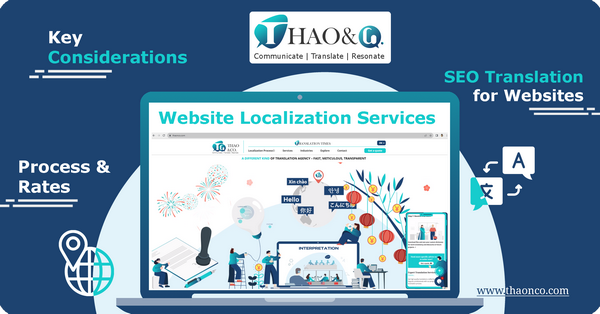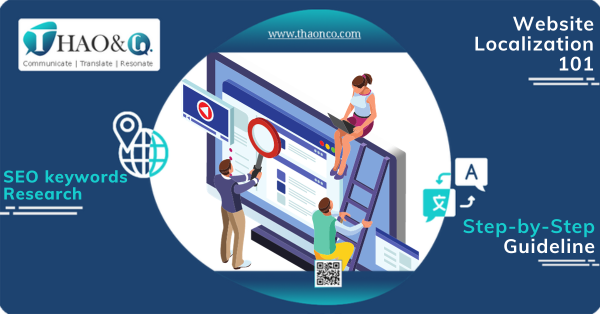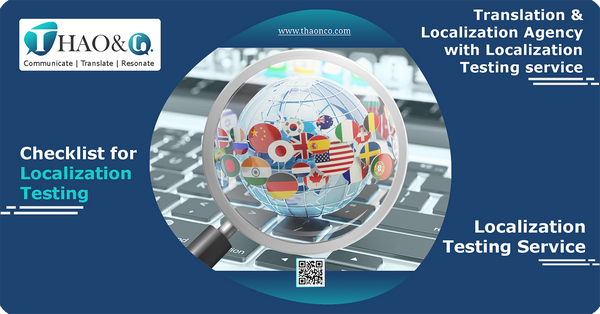Website localization is the process of converting website content and information from one language to another. This may include adjusting the layout, interface, and even the website structure.
The purpose of localization is to tailor the website to new markets, aiding businesses in promoting their products and services. Here are 5 fundamental steps for a professional website localization process.
Each business will have different products, services, markets, or target customers. Therefore, the content to be shared on websites varies significantly. This can be considered the most crucial step in the website localization process.
In this step, the translation team will conduct research on the business, products, services, and target markets. With an overall view of the industry and products, translators will plan the content, outlining the tasks to be carried out.
Typically, a website’s content, in addition to text articles, includes images, audio files, videos, infographics, and more. Furthermore, geographical changes also require adjustments to website elements such as time, location, and payment methods.
Thoroughly researching website content facilitates a smooth translation process, allowing translators to grasp the content easily and minimizing the need for revisions. Therefore, before jumping into the website localization process, the translation team should spend time researching the content and the business’s objectives.

The advantage of websites is their ability to bring in new organic traffic without incurring additional costs. However, this only happens when the website is SEO-optimized and achieves high keyword rankings. Companies or businesses often face challenges in reaching a new market or a new language on their websites.
Besides linguists, multilingual SEO keyword research requires contributions from SEO experts. This collaboration helps achieve effectiveness in the localization marketing strategy. Using keyword research tools, analytical, assessment, selection, and organization skills, experts will identify a list of keywords that the website needs to optimize to achieve high rankings on search engines.
Building SEO keyword glossary is one of the crucial steps in the website localization process. Right from the beginning of the website translation planning phase, businesses should have an SEO strategy to achieve the best communication effectiveness and minimize the need for content revisions.
The reason is that optimizing SEO for a website involves numerous steps, such as researching customer search habits, competitors, keywords, and backlinks in the target market.

Based on content and keyword research, translators will proceed with the translation. Understanding local content and search habits will help translators provide translations that meet SEO standards in matters such as titles, keyword density, article structure, H tags, meta descriptions, links, and more.
Proofreading, also known as reviewing or editing a translation, is the process of comparing and checking the translation against the original. Proofreading is carried out right after the translation step has been completed. In this way, the translation is reviewed, edited, ensuring writing style and meaning.
Proofreading not only checks for spelling, grammar, or sentence structure errors but also ensures the translation aligns with the local culture, customs, and practices. Specifically at Thao & Co., translation and proofreading are conducted concurrently to optimize the project execution time, ensuring you receive the finalized translation quickly while maintaining accuracy and thoroughness.
Both translation and proofreading are indispensable steps in the website localization process. Furthermore, to achieve high-quality translation, both of these steps require support from native linguists. These are professionals who possess a combination of translation skills and extensive knowledge of culture, language, and local customs.
Today, websites need to meet various criteria for speed, content, user experience, SEO localization, and more. Therefore, the integration of translations needs to be handled correctly.
There are 2 methods to integrate translations: custom integration and automatic integration.
Among them, automatic integration can help save time and effort. The translation will be integrated automatically through a third-party API.
On the contrary, custom integration requires coordination with programmers to update translations to the website. Custom integration may take more time, but it can help businesses ensure factors related to browsing experience, security, management, and quality control.
With the ability to optimize the user experience and especially the level of web security, custom integration is a comprehensive solution to expand the market and reach potential customers.
The custom integration and review process can be divided into the following steps:
The website will undergo compatibility testing after adding multilingual features before moving on to the Localization Testing process.

This is the final step in the website localization process. The purpose of this step is to ensure that the website is localized accurately and appropriately.
Localization testing will involve multiple steps to ensure that all elements of the interface, language, date formats, currency, and symbols are suitably chosen. Other functions on the website such as payment, search, registration, login, etc., also need to be tested.
Here is the process of localization testing:
The testing team needs to determine the language requirements and the target market profile. From there, experts can assess the accuracy of language usage and terminology.
All information on the website, including the content, usage instructions, product introductions, etc., needs to be presented in a clear, contextually appropriate way without font errors.
Besides language, the interface is another vital component of a website. UI/UX experts not only check if the interface looks visually engaging and logically displayed but also ensure compatibility across various mobile devices.
The reason is that the translation process may affect the length of the content. Furthermore, web elements also need adjustments to align with the new market, such as symbols, icons, function buttons, notifications, and more.
After integrating the translation, the website needs to undergo testing for all functionalities. This is done to minimize any errors that may occur during the translation integration process. In addition to the inherent features of the website such as registration, login, purchasing, and payment, programmers need to test the website’s functionality across various devices and systems.
The final step in the localization testing process is comprehensive testing. Experts need to test the website in a real-world environment and on various devices and systems. If any errors are detected, it is essential to make notes, report them, and propose solutions as soon as possible.
It can be seen that the website localization process is relatively complex. Due to the need for expertise from multiple parties, businesses often waste precious time and effort navigating back and forth between each service provider.
Understanding this, Thao & Co. translation agency has come up with a comprehensive solution offering a variety of translation services tailored for B2B customers.
The standard website localization process at Thao & Co. ensures that your website is accurately and professionally translated.
 After receiving your request, our Project Manager and Language Lead will have in-depth discussions with you to create the Translation Guideline. Next, SEO experts will conduct SEO keyword research in the target market.
After receiving your request, our Project Manager and Language Lead will have in-depth discussions with you to create the Translation Guideline. Next, SEO experts will conduct SEO keyword research in the target market.
 The website translation services will be carried out by a team of native linguists with extensive expertise in advertising and marketing. The translation and proofreading steps are conducted simultaneously to be more time-efficient while ensuring accurate and engaging translations to attract customers.
The website translation services will be carried out by a team of native linguists with extensive expertise in advertising and marketing. The translation and proofreading steps are conducted simultaneously to be more time-efficient while ensuring accurate and engaging translations to attract customers.
 The final steps are Custom Integration and content review, our programmers will integrate the translated and localized content into your website, ensuring consistency in design, layout, and functionality. Before being delivered, the translation will undergo a final review to ensure that the language is optimized for local culture and user experience.
The final steps are Custom Integration and content review, our programmers will integrate the translated and localized content into your website, ensuring consistency in design, layout, and functionality. Before being delivered, the translation will undergo a final review to ensure that the language is optimized for local culture and user experience.
Additionally, you can develop personalized content strategies for the target market with our SEO Multilingual Content service. This service provides everything you need to take your website international.

In addition to the standard translation process, Thao & Co. also offers access to our proprietary technology platform that allows users to submit requests directly to the project management team and track project progress easily while maintaining absolute confidentiality.
We hope that this article has provided you with useful information. To explore more about our website translation services, please visit the Get a Quote page of Thao & Co.